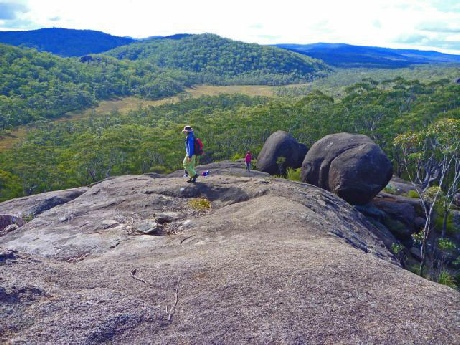

Gibraltar Range National Park

Gibraltar Range National Park
Gibraltar Range has so many plants and animals descended from the dinosaur age, that it’s part of the Gondwana Rainforests of Australia, a series of parks and reserves stretching from Barrington Tops to southern Queensland. That’s only the start of what makes this a remarkable place.
Strike out on a mountain biking track past huge granite outcroppings that oversee ancient rainforest. Swim in creeks surrounded by signs of early colonial history. Camp in fragrant woodlands and listen to giant barred frogs during their nightly chorus. Take a morning walk for the waratahs and Christmas bells, or stock the backpack and embark on a rugged adventure for many days. There are sweeping lookouts and swooping yellow-
Gibraltar Range National Park is a rarity; historic and appealing to a modern audience, a treasure for heritage buffs, naturalists, adventure junkies, and people just looking for a quiet place to appreciate the wonders of the state.
Native animals
Mammals
The forests support many small mammals, especially where old or dead trees provide hollows for nests and shelter. In the last 200 years many animals have lost their habitat due to clearing. Unless we can reverse this habitat loss on private lands, these animals will have to depend on national parks for their long term survival.
Locally such animals include the koala, spotter-
Birds
Gibraltar Range National Park is rich in more than 140 species of bird life. Rare species like the rufous-
The rufous scrub-
Amphibians and reptiles
The park's lizards, snakes and frogs are restricted to particular habitats and are rarely seen.
The forests and swamps in the park support many kinds of frog, including the unusual pouched frog, a curious rainforest-
Philoria sp. nov. B, the locally endemic species of sphagnum frog, is currently being formally described and named. It has been recorded in Gibraltar Range National Park and is found in rainforests and wet open forest near streams and seepage lines.
Invertebrates
A recent report has been prepared for the invertebrate fauna of the Central Eastern Rainforest Reserves of Australia. Endemic species of velvet worm (type locality Gibraltar Range) and spiny cray have been described from the park.
Landscape and Geology
How the park's landscape formed
The park's landforms are a legacy of ancient volcanic activity, followed by faulting and uplift. The ancient igneous complex east of the Demon Fault is in stark contrast with the even older underlying meta-
Most of the igneous units date from the late Permian (approximately 250 million years ago) and include the following broad groupings of rock:
* andesite and rhyodacites which underlie much of the eastern half of Washpool National Park
* an intrusion of adamellite in the south-
* granites, which cover the Dandahra Plateau of the Gibraltar Range; and
* Emmaville volcanics occurring in isolated peaks in the western section of Washpool National Park and Barool National Park.
The perched boulders which are major features of the landscape of Gibraltar Range National Park are formed from granite, rhyodacite and adamellite. The most spectacular have been weathered from the Dandahra Creek granites.
Interesting features in the park
The Gibraltar Range National Park area includes a dramatic landscape of steep-
The dominant landform features of the area are:
* a series of high ridges and plateaus which form the Gibraltar Range
* the Demon Fault which cuts the bedrock north-
* the rocks and soils are very different on either side of Boundary Creek -
* the Great Eastern Escarpment
* steep-
* cascades, clear running streams and waterfalls, including the Dandahra Falls and Little Dandahra Creek, and
* dramatic granitic rock formations, including outcrops and balancing tors.
World Heritage
Gibraltar Range and the adjoining Washpool National Park are included on the World Heritage List as part of the Gondwana Rainforests of Australia World Heritage Area. The Gondwana Rainforests of Australia World Heritage Area was added to the World Heritage List in 1986 because of its ancient and isolated remnants of rainforest with a great variety of plant and animal species. Gondwana Rainforests of Australia compromises over 40 separate reserves including the Barrington Tops, New England, Mt Warning and Lamington national parks.
Wilderness
Most of Gibraltar Range National Park is part of the Bindery-
© State of New South Wales through the Office of Environment and Heritage
Click the link for more information about Gibraltar Range National Park

View of Surveyors Creek from Dandahra Crags
Photos of Gibraltar Range NP, Dandahra Crags, Anvil Rock
Photos of Murrumbooee Cascades, The Needles, Mulligans Hut
Photos of Dandahra Falls, Anvil Rock, Dandahra Crags, Needles